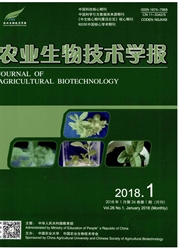

 中文摘要:
中文摘要:
发光细菌携带的lux基因簇能够利用体内脂肪酸分子和氧化还原反应产生自发荧光。本研究将携带lux基因簇的质粒转化到大肠杆菌(Escherichia coli)DH5α感受态细胞中,测定发光大肠杆菌的生长曲线和荧光光谱等生物学特性;同时,利用活体成像系统(ⅣIS)检测其生物发光活性,并收集对数生长期的发光大肠杆菌,注射到ICR小鼠(Mus musculus)盲肠内,24h后检测小鼠肠道内微生物的荧光反应。结果显示,转lux基因簇的大肠杆菌能够产生较强的蓝绿荧光,持续发光16h以上,且在完成肠道注射后能够观测到发光菌的荧光,表明发光大肠杆菌可在不影响小鼠正常生理活动的条件下完成在肠道内的定植。本研究初步建立了大肠杆菌在小鼠肠道内生存变化的实验模型,为进一步监测致病性大肠杆菌在动物肠道内的活动和致病机制的研究提供了新的实验方法。
 英文摘要:
英文摘要:
Lux operon codes a series of proteins that mediate the autofluorescence of luminous bacteria by catalyzing long-chain fatty acids molecules through the oxidation reduction reactions. Methods for constructing luminescent Escherichia coli transformed with lux operon were introduced to study distribution and survival ofE. coli in vitro and in vivo. In this study, we transformed the pL1217 plasmid carrying with lux operon into E.coli DHSα strain, and performed the biological characteristics of E. coli growth curve assay and fluorescence spectrum analysis of lux operon. Meanwhile, the bioluminescent assay of E. coli transfected with lux operon were performed by infrared video data imaging system (IVIS) kinetics to test whether the luminous bacteria could inherited stably in vivo. The E. coli cells with lux operon at the log phase were collected and injected into the cecum of ICR mouse (Mus musculus). 24 h after infection, fluorescent bacteria from mouse small intestine occurred and the number of the bacteria was counted. The results showed that the E. coli transfected with lux operon in log phase produced strong blue/green fluorescence that last more than 16 h in vivo, and indicated that E. coli cells were capable of colonizing in small intestine and maintaining fluorescence without disturbing its normal activities. The study of E. coli cells colonizing in mouse bowel provides anexperimental model that can be used to monitor the pathogenic E. coli activities in animal bowel in vivo and investigate the pathogenesis enteral infections by bacteria.
 同期刊论文项目
同期刊论文项目
 同项目期刊论文
同项目期刊论文
 期刊信息
期刊信息
